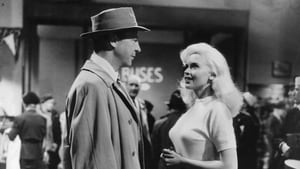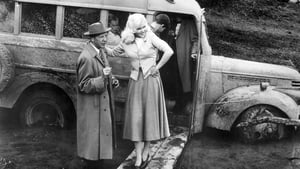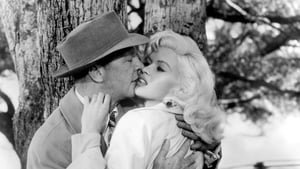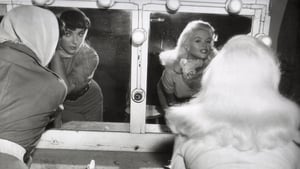Contact: info@alwanfilm.com
Video Sources 0 Views

The Wayward Bus 1957 Colorized
Synopsis
The Wayward Bus 1957 Colorized Review: A Journey Through Turbulence and Human Drama

Introduction
The Wayward Bus (1957), directed by Victor Vicas and based on the novel by Nobel Prize-winning author John Steinbeck, is a film that takes its audience on a gripping journey through the human condition. Set against the backdrop of post-war America, the film explores the intertwining lives of a group of passengers on a rickety bus navigating the rough terrains of California. As an early color film, The Wayward Bus stands out for its compelling character studies, vivid visuals, and complex storytelling. This review will delve into the film’s cast, story, and colorization, highlighting its significance in cinema history and its enduring impact on audiences.
Check The Full Colorized Movies List
Check Our Colorized Movies Trailer Channel
Understanding The Wayward Bus 1957 Colorized: Director, Cast, and Genre
Victor Vicas’ Vision for The Wayward Bus
Victor Vicas, a director with a keen eye for drama and human emotions, was tasked with bringing Steinbeck’s complex characters and narrative to life on the big screen. Vicas’ vision for The Wayward Bus was to capture the essence of Steinbeck’s novel—its exploration of flawed, deeply human characters who are each on a personal journey. Vicas succeeded in creating a film that is as much about the physical journey as it is about the emotional and psychological struggles of its characters. The director’s focus on realism, combined with the technical challenges of shooting in color, helped make The Wayward Bus a unique entry in the annals of 1950s American cinema.
The Iconic Performance of Actors
The Wayward Bus boasts an impressive ensemble cast, with each actor bringing depth and nuance to their roles. The film stars Joan Collins as Alice Chicoy, a disillusioned and troubled wife whose marital strife is one of the film’s central conflicts. Collins’ portrayal of Alice is both fiery and vulnerable, capturing the complexity of a woman trapped in an unhappy marriage and searching for a way out.
Opposite Collins is Rick Jason as Johnny Chicoy, the bus driver who is as unreliable as the titular vehicle he operates. Jason’s performance as Johnny adds layers of charm and frustration, portraying a man caught between his responsibilities and his desire for freedom. Jayne Mansfield, in a departure from her usual glamorous roles, plays Camille Oakes, a burlesque dancer seeking a fresh start. Mansfield’s portrayal of Camille is one of the film’s highlights, offering a poignant and sympathetic look at a woman striving to escape her past.
Exploring the Genre
The Wayward Bus fits squarely within the drama genre, though it also incorporates elements of road movies and social commentary. Set in the dusty landscapes of rural California, the film explores the intersecting lives of its characters as they navigate both literal and figurative crossroads. The narrative unfolds primarily on the bus, turning this confined space into a microcosm of human hopes, fears, and conflicts. The film’s exploration of themes like existential disillusionment and personal redemption elevates it beyond a typical road movie, making it a thought-provoking drama that captures the spirit of its source material.
Exploring the World of The Wayward Bus 1957 Colorized: Plot and Characters
Detailed Synopsis
The story of The Wayward Bus revolves around a dilapidated bus named “Sweetheart,” driven by Johnny Chicoy. Johnny operates a small, struggling bus line that connects remote towns in California. The passengers who board the bus on this fateful journey are each dealing with their own personal issues, creating a melting pot of emotions, secrets, and unspoken tensions.
Among the passengers are Camille Oakes (Jayne Mansfield), a burlesque dancer fleeing her past; Ernest Horton (Dan Dailey), a traveling salesman grappling with his own loneliness; and the Pritchard family, a wealthy but unhappy couple with their young daughter. As the bus travels through treacherous terrain, the passengers’ individual stories begin to unravel, revealing hidden desires, regrets, and conflicts.
Key moments in the film include the bus’s struggle through mudslides, breakdowns, and the rising tension among the passengers. As the journey becomes increasingly perilous, the characters are forced to confront their own fears and insecurities, leading to moments of both confrontation and unexpected camaraderie.
Complex Protagonists and Memorable Supporting Characters
The film’s strength lies in its character-driven narrative. Alice Chicoy’s complex relationship with her husband Johnny serves as the emotional core of the story. Her dissatisfaction with her life and marriage is palpable, and her interactions with the other passengers reveal the depth of her character.
Camille Oakes, portrayed by Mansfield, emerges as one of the most sympathetic characters, challenging the stereotypes often associated with her glamorous public persona. Her portrayal of a woman seeking redemption adds a layer of emotional resonance to the film. Meanwhile, the supporting characters, from the boisterous Ernest to the conflicted Pritchards, each add to the film’s rich tapestry of human experience.
The Art of Film Colorization
Understanding the Process
Colorization, particularly in the 1950s, was a developing art form. By 1957, the process had evolved significantly, with Technicolor and Eastmancolor becoming more widely used. These color processes allowed filmmakers to create vibrant, realistic hues that brought stories to life in a new way. The art of colorization involves careful planning of each scene’s palette, lighting, and costume design to ensure a visually cohesive and aesthetically pleasing film.
For The Wayward Bus, colorization played an essential role in setting the mood and enhancing the storytelling. The choice of muted, earthy tones reflects the dusty, rural landscapes of California, while the vivid colors used in character costumes emphasize their distinct personalities and inner conflicts.
Development Over Time
Color films in the 1950s were seen as a symbol of modernity and technological progress. The transition from black-and-white to color was not merely a technical upgrade; it was also an artistic choice that could significantly alter a film’s tone and visual narrative. For directors like Victor Vicas, working in color presented both opportunities and challenges, allowing for more expressive visuals while demanding a higher level of precision in terms of lighting and set design.
Early Colored Films: A Brief History
The Emergence of Color in Cinema
The journey to full-color films began in the early 20th century with hand-tinted films and early two-color processes such as Kinemacolor. These early methods were often costly and labor-intensive, but they set the stage for the development of more sophisticated color technologies. By the 1930s, Technicolor had become the leading color process, famously used in classics like The Wizard of Oz (1939) and Gone with the Wind (1939).
The 1950s saw the widespread adoption of color films as the standard, thanks in part to advancements in Eastmancolor, which was more economical and easier to use than previous technologies. This era marked a turning point in cinematic history, as filmmakers embraced the expressive potential of color to enhance storytelling and create more immersive worlds.
The Wayward Bus (1957) and Its Early Colored Version
The Significance of Its Colored Format
The decision to release The Wayward Bus in color was pivotal in capturing the raw, gritty atmosphere of Steinbeck’s world. The colorization brought a level of realism to the film that enhanced the audience’s connection to the story. The dusty roads, sun-soaked landscapes, and worn-out bus are brought vividly to life, grounding the narrative in a tangible setting.
The use of color also serves to underscore the emotional states of the characters. The bright, flashy colors associated with Camille’s wardrobe reflect her flamboyant, outward persona, contrasting with the more subdued, earth-toned clothing of Alice, symbolizing her internal struggles and the dullness of her current life.
The Debate Over Film Colorization
Controversy and Criticism
The colorization of films, particularly those originally intended for black-and-white, has long been a subject of debate. Some purists argue that colorization can detract from the film’s original artistic intent, altering the mood and tone established by the filmmakers. For films like The Wayward Bus, which were shot in color from the outset, the debate centers more on whether the color palette chosen by the filmmakers effectively serves the narrative.
Proponents of colorization see it as a way to enhance the visual experience, making films more appealing to modern audiences who may be less accustomed to black-and-white imagery. In the case of The Wayward Bus, the colorization complements the story, helping to define the setting and amplify the characters’ emotional journeys.
Examining The Wayward Bus (1957) as an Early Colored Film
How Colorization Enhances the Viewing Experience
The colorization of The Wayward Bus contributes significantly to the film’s overall impact. The use of color not only enhances the visual storytelling but also deepens the viewer’s engagement with the characters and their surroundings. The earthy, muted tones of the landscape serve as a visual metaphor for the characters’ struggles, while the more vibrant colors used sparingly highlight moments of hope, desire, and conflict.
The visual contrast between the dusty environment and the colorful costumes draws the audience’s attention to key narrative elements, guiding their emotional response throughout the film. The colorized format adds a layer of realism that helps ground the story in its specific time and place, making the characters’ journey feel all the more authentic.
Influence and Legacy: The Wayward Bus 1957 Colorized’s Impact on Cinema
Steinbeck’s Influence on Adaptations
The Wayward Bus is one of several Steinbeck adaptations that have made their mark on cinema, alongside other notable films like East of Eden (1955) and Of Mice and Men (1939). Steinbeck’s focus on flawed, deeply human characters and social realism resonated with audiences of the 1950s, a time when American society was grappling with its own post-war disillusionment.
The film’s exploration of human vulnerability and resilience had a lasting impact on the drama genre, inspiring subsequent films that delved into complex, character-driven narratives. The way The Wayward Bus navigates its themes of redemption and personal struggle continues to resonate with audiences, cementing its place in cinematic history.
Director’s Cinematic Legacy: Beyond The Wayward Bus 1957 Colorized
Victor Vicas’ Contribution to Film
Victor Vicas’ work on The Wayward Bus solidified his reputation as a director capable of handling intricate character dynamics and emotionally charged stories. Although his filmography is not as extensive as some of his contemporaries, Vicas’ ability to capture the subtleties of human behavior on screen has left a lasting legacy. His direction of The Wayward Bus is a testament to his talent for blending narrative tension with rich, atmospheric visuals.
Themes Explored in The Wayward Bus 1957 Colorized
Darkness, Redemption, and Human Complexity
At its core, The Wayward Bus is a film about redemption and the complexity of the human spirit. The characters’ individual journeys, filled with moments of darkness, hope, and reconciliation, reflect the broader struggles of post-war America. The film tackles themes of disillusionment, personal failure, and the search for new beginnings, making it a deeply relatable story for audiences of its time—and today.
Reception and Controversy Surrounding The Wayward Bus (1957)
Critical Reception
The Wayward Bus received mixed reviews upon its release. While some praised the performances, particularly those of Joan Collins and Jayne Mansfield, others felt the film fell short of capturing the full depth of Steinbeck’s novel. The colorized presentation, however, was generally well-received, with many noting that it added a layer of visual interest to the film’s narrative.
Where to Watch The Wayward Bus 1957 Colorized Online
Fans of classic cinema can find The Wayward Bus available for streaming on various platforms, including Amazon Prime Video and Apple TV. The film is also available for purchase on DVD, allowing viewers to experience both the visual splendor and the human drama of this iconic 1957 release.
FAQs About The Wayward Bus 1957 Colorized
Q: Was The Wayward Bus filmed in color originally?
A: Yes, The Wayward Bus was filmed in color, reflecting the transition of the era from black-and-white films to more vibrant, realistic color films.
Q: How does The Wayward Bus differ from Steinbeck’s novel?
A: While the film remains faithful to the main storyline, certain character details and subplots were altered or condensed for the adaptation, a common practice when adapting complex novels for the screen.
Q: What are the main themes of The Wayward Bus?
A: The film explores themes of personal redemption, human vulnerability, and the struggle for new beginnings amidst adversity.
Conclusion
The Wayward Bus (1957) is a compelling exploration of the human condition, brought to life by a talented ensemble cast and the directorial vision of Victor Vicas. Its use of color not only enhances the storytelling but also serves as a reflection of the characters’ internal landscapes. While the film sparked debate over its fidelity to Steinbeck’s original novel, it remains a powerful piece of cinema that captures the complexities of its characters and the era it represents. Whether viewed as a dramatic road movie or a deeper social commentary, The Wayward Bus continues to resonate, reminding us of the timeless nature of human struggle and hope.














